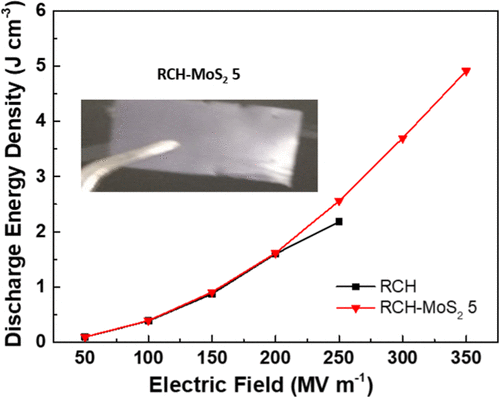当前位置:
X-MOL 学术
›
Biomacromolecules
›
论文详情
Our official English website, www.x-mol.net, welcomes your
feedback! (Note: you will need to create a separate account there.)
Chitin/MoS2 Nanosheet Dielectric Composite Films with Significantly Enhanced Discharge Energy Density and Efficiency.
Biomacromolecules ( IF 5.5 ) Pub Date : 2020-05-29 , DOI: 10.1021/acs.biomac.0c00732 Huan Chen 1 , Xueqian Li 1 , Wenchao Yu 1 , Jinyu Wang 1 , Zhuqun Shi 1, 2 , Chuanxi Xiong 1 , Quanling Yang 1
Biomacromolecules ( IF 5.5 ) Pub Date : 2020-05-29 , DOI: 10.1021/acs.biomac.0c00732 Huan Chen 1 , Xueqian Li 1 , Wenchao Yu 1 , Jinyu Wang 1 , Zhuqun Shi 1, 2 , Chuanxi Xiong 1 , Quanling Yang 1
Affiliation

|
High-performance dielectric nanomaterials have received increasing attention due to their important applications in the field of energy storage. Among various dielectric materials, polymer nanocomposite is one of the most promising candidates. However, the problems of environmental pollution caused by polymer-based dielectric materials have been extensively studied in recent years, which need to be solved urgently, leading to the search for new biodegradable dielectric materials. Herein, we report composite materials based on biodegradable and renewable chitin and molybdenum disulfide (MoS2) nanosheets for the first time. The MoS2 nanosheets were first fabricated by glycerol/urea system and then KOH/urea aqueous solution was used to directly dissolve chitin at low temperature together with the dispersion of the MoS2 nanosheets in a simple green process. The two-dimensional MoS2 nanosheets possess high polarization strength, and a large specific surface area can enhance the interfacial polarization with chitin; meanwhile, it can serve as a charge breakdown barrier to hinder the propagation of electrical tree branches. The results also show that the dielectric constant and breakdown strength of the chitin/MoS2 nanocomposites were increased, while the dielectric loss remained low. When the MoS2 content was 5 wt %, the charge and discharge efficiencies of the composite film were more than 80%, and the breakdown strength also reached 350 MV m–1, thus resulting in a high discharge energy density of 4.91 J cm–3, which was more than twice of the neat chitin (2.17 J cm–3). Furthermore, the nanocomposite films exhibited good thermal stability. Therefore, these chitin-based nanocomposite films are promising as high-performance biomass-based dielectric capacitors.
中文翻译:

几丁质/ MoS2纳米片介电复合膜具有显着增强的放电能量密度和效率。
高性能介电纳米材料由于其在储能领域中的重要应用而受到越来越多的关注。在各种介电材料中,聚合物纳米复合材料是最有前途的候选材料之一。然而,近年来,对基于聚合物的电介质材料引起的环境污染问题进行了广泛的研究,迫切需要解决这一问题,从而寻求新的可生物降解的电介质材料。在这里,我们首次报道了基于可生物降解和可再生的几丁质和二硫化钼(MoS 2)纳米片的复合材料。MoS 2首先通过甘油/脲系统制备纳米片,然后使用KOH /尿素水溶液在低温下直接溶解几丁质以及MoS 2纳米片的分散,并且过程简单。二维MoS 2纳米片具有较高的极化强度,较大的比表面积可增强与几丁质的界面极化。同时,它可以作为电荷击穿屏障,阻碍电子树枝的传播。结果还表明,几丁质/ MoS 2纳米复合材料的介电常数和击穿强度增加,而介电损耗却保持较低。当MoS 2含量为5 wt%,复合膜的充放电效率超过80%,击穿强度也达到350 MV m –1,因此产生了4.91 J cm –3的高放电能量密度,这是是纯甲壳素的两倍以上(2.17 J cm –3)。此外,纳米复合膜表现出良好的热稳定性。因此,这些基于甲壳质的纳米复合膜有望用作高性能的基于生物质的介电电容器。
更新日期:2020-07-13
中文翻译:

几丁质/ MoS2纳米片介电复合膜具有显着增强的放电能量密度和效率。
高性能介电纳米材料由于其在储能领域中的重要应用而受到越来越多的关注。在各种介电材料中,聚合物纳米复合材料是最有前途的候选材料之一。然而,近年来,对基于聚合物的电介质材料引起的环境污染问题进行了广泛的研究,迫切需要解决这一问题,从而寻求新的可生物降解的电介质材料。在这里,我们首次报道了基于可生物降解和可再生的几丁质和二硫化钼(MoS 2)纳米片的复合材料。MoS 2首先通过甘油/脲系统制备纳米片,然后使用KOH /尿素水溶液在低温下直接溶解几丁质以及MoS 2纳米片的分散,并且过程简单。二维MoS 2纳米片具有较高的极化强度,较大的比表面积可增强与几丁质的界面极化。同时,它可以作为电荷击穿屏障,阻碍电子树枝的传播。结果还表明,几丁质/ MoS 2纳米复合材料的介电常数和击穿强度增加,而介电损耗却保持较低。当MoS 2含量为5 wt%,复合膜的充放电效率超过80%,击穿强度也达到350 MV m –1,因此产生了4.91 J cm –3的高放电能量密度,这是是纯甲壳素的两倍以上(2.17 J cm –3)。此外,纳米复合膜表现出良好的热稳定性。因此,这些基于甲壳质的纳米复合膜有望用作高性能的基于生物质的介电电容器。











































 京公网安备 11010802027423号
京公网安备 11010802027423号